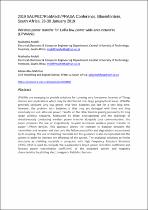JavaScript is disabled for your browser. Some features of this site may not work without it.
- ResearchSpace
- →
- Research Publications/Outputs
- →
- Conference Publications
- →
- View Item
| dc.contributor.author |
Molefi, M

|
|
| dc.contributor.author |
Markus, ED

|
|
| dc.contributor.author |
Abu-Mahfouz, Adnan MI

|
|
| dc.date.accessioned | 2019-08-28T08:22:37Z | |
| dc.date.available | 2019-08-28T08:22:37Z | |
| dc.date.issued | 2019-06 | |
| dc.identifier.citation | Molefi, M., Markus, E.D. & Abu-Mahfouz, A.M.I. 2019. Wireless power transfer for LoRa low-power wide-area networks (LPWANs). In: 2019 SAUPEC/RobMech/PRASA Conference, Bloemfontein, South Africa, 28-30 January 2019 | en_US |
| dc.identifier.isbn | 978-1-7281-0369-3 | |
| dc.identifier.isbn | 978-1-7281-0368-6 | |
| dc.identifier.isbn | 978-1-7281-0370-9 | |
| dc.identifier.uri | https://ieeexplore.ieee.org/document/8704805 | |
| dc.identifier.uri | https://az817975.vo.msecnd.net/wm-418498-cmsimages/SAUPEC2019Preliminaryprogrammereview2.pdf | |
| dc.identifier.uri | DOI: 10.1109/RoboMech.2019.8704805 | |
| dc.identifier.uri | http://hdl.handle.net/10204/11111 | |
| dc.description | Presented in: 2019 SAUPEC/RobMech/PRASA Conference, Bloemfontein, South Africa, 28-30 January 2019. Due to copyright restrictions, the attached PDF file contains the abstract of the full-text item. For access to the full-text item, please consult the publisher's website. https://ieeexplore.ieee.org/document/8704805 | en_US |
| dc.description.abstract | LPWANs are emerging to provide solutions for covering very low-power Internet of Things devices and applications which may be distributed over large geographical areas. LPWANs generally consume very low power thus their batteries can last for a very long time. However, the problem with batteries is that they get damaged with time and they eventually run out. Wireless power transfer on the other hand is gaining popularity for long range wireless networks. Motivated by these developments and the challenge of simultaneously conducting wireless power transfer alongside data communication, this paper proposes the use of magnetically coupled resonance wireless power transfer to power LPWAN devices. This approach allows the increase in distance between the transmitter and receiver and also curb the failure probability and degradation encountered by its coupling. The use of shielding materials and flux guidance is also incorporated into the system in order to increase the efficiency of the system. The analytical solutions to ferrite structures as shielding materials is computed with High Frequency Structure Simulator (HFSS). HFSS is used to compute the S-parameters (input power reflection coefficient and forward power transmission coefficient) of the proposed system and magnetic characteristics by plotting electromagnetic field distributions. | en_US |
| dc.language.iso | en | en_US |
| dc.publisher | IEEE | en_US |
| dc.relation.ispartofseries | Workflow;22623 | |
| dc.subject | Ferrite materials | en_US |
| dc.subject | High Frequency Structure Simulator | en_US |
| dc.subject | HFSS | en_US |
| dc.subject | S-parameters | en_US |
| dc.subject | LPWANs | en_US |
| dc.subject | Magnetically Coupled Resonance | en_US |
| dc.subject | MCR | en_US |
| dc.subject | Wireless Power Transfer | en_US |
| dc.subject | WPT | en_US |
| dc.title | Wireless power transfer for LoRa low-power wide-area networks (LPWANs) | en_US |
| dc.type | Conference Presentation | en_US |
| dc.identifier.apacitation | Molefi, M., Markus, E., & Abu-Mahfouz, A. M. (2019). Wireless power transfer for LoRa low-power wide-area networks (LPWANs). IEEE. http://hdl.handle.net/10204/11111 | en_ZA |
| dc.identifier.chicagocitation | Molefi, M, ED Markus, and Adnan MI Abu-Mahfouz. "Wireless power transfer for LoRa low-power wide-area networks (LPWANs)." (2019): http://hdl.handle.net/10204/11111 | en_ZA |
| dc.identifier.vancouvercitation | Molefi M, Markus E, Abu-Mahfouz AM, Wireless power transfer for LoRa low-power wide-area networks (LPWANs); IEEE; 2019. http://hdl.handle.net/10204/11111 . | en_ZA |
| dc.identifier.ris | TY - Conference Presentation AU - Molefi, M AU - Markus, ED AU - Abu-Mahfouz, Adnan MI AB - LPWANs are emerging to provide solutions for covering very low-power Internet of Things devices and applications which may be distributed over large geographical areas. LPWANs generally consume very low power thus their batteries can last for a very long time. However, the problem with batteries is that they get damaged with time and they eventually run out. Wireless power transfer on the other hand is gaining popularity for long range wireless networks. Motivated by these developments and the challenge of simultaneously conducting wireless power transfer alongside data communication, this paper proposes the use of magnetically coupled resonance wireless power transfer to power LPWAN devices. This approach allows the increase in distance between the transmitter and receiver and also curb the failure probability and degradation encountered by its coupling. The use of shielding materials and flux guidance is also incorporated into the system in order to increase the efficiency of the system. The analytical solutions to ferrite structures as shielding materials is computed with High Frequency Structure Simulator (HFSS). HFSS is used to compute the S-parameters (input power reflection coefficient and forward power transmission coefficient) of the proposed system and magnetic characteristics by plotting electromagnetic field distributions. DA - 2019-06 DB - ResearchSpace DP - CSIR KW - Ferrite materials KW - High Frequency Structure Simulator KW - HFSS KW - S-parameters KW - LPWANs KW - Magnetically Coupled Resonance KW - MCR KW - Wireless Power Transfer KW - WPT LK - https://researchspace.csir.co.za PY - 2019 SM - 978-1-7281-0369-3 SM - 978-1-7281-0368-6 SM - 978-1-7281-0370-9 T1 - Wireless power transfer for LoRa low-power wide-area networks (LPWANs) TI - Wireless power transfer for LoRa low-power wide-area networks (LPWANs) UR - http://hdl.handle.net/10204/11111 ER - | en_ZA |






